Zhang et al. EURASIP Journal on Wireless Communications
and Networking (2016) 2016:241
DOI 10.1186/s13638-016-0738-6
R ES EAR CH
MRT precoding in downlink multi-user
MIMO systems
Yinghui Zhang1, Jing Gao2* and Yang Liu1
Open Access
Abstract
This paper focuses on the design of maximum ratio transmission (MRT) precoding for multi-user multiple-input
multiple-output (MU-MIMO) downlink transmission. Exiting block diagonalization (BD) precoding studies on MU-
MIMO systems have the high complexity, because the transmitter precoding matrices constructed by singular value
decomposition (SVD) are successively calculated twice. The MRT scheme construct precoding vectors aimed at each
received antennas, respectively, so the signals of every antenna are independent. More spatial diversity gain can be
obtained compared with BD precoding when MRT precoding and maximum ratio combining are employed.
Simulations show that the proposed algorithm has many gains over the conventional BD precoding in various
MU-MIMO systems.
Keywords: MU-MIMO, Precoding, Multi-user interference, Maximum ratio transmission
1 Introduction
The envisioned rapid increase of the wireless data traffic de-
mand in the next years imposes rethinking current wireless
cellular networks [1]. Multi-user (MU) multiple-input
multiple-output (MIMO) systems have the potential of
combining the high capacity by MIMO processing with the
benefits of space-division multiple access (SDMA) [2]. In
general, MU-MIMO systems not only suffer from the noise
and the inner-antenna interference but are also affected by
multi-user interference (MUI) during downlink transmis-
sion, which is means of channel-aware precoding methods
implemented at the base station (BS). Precoding techniques
for MIMO transmissions have recently gained increasing
interest with the introduction of MU-MIMO, in which a
large number of transmit antennas are used at the base sta-
tion to simultaneously serve multiple receivers [3]. Nonlin-
ear precoding methods such as dirty paper coding are
performance achieving. However,
these precoding are
highly complex, thereby motivating the need for linear
methods, which are computationally simpler. Channel
inversion-based linear precoding algorithms such as zero-
forcing channel inversion (ZF-CI) can still be used to cancel
the MUI with the lower complexity. As the generalization
* Correspondence: jing401@126.com
2Tianjin Key Laboratory of Wireless Mobile Communications and Power
Transmission, Tianjin Normal University, Tianjin 300387, China
Full list of author information is available at the end of the article
of the ZF-CI precoding algorithm, the block diagonalization
(BD) and regularized block diagonalization (RBD) precod-
ing have been proposed for MU-MIMO systems in [4–6].
Singular value decomposition (SVD) operations are imple-
mented twice for each user in BD precoding algorithm.
Over the last few years, many works have analyzed the
zero-forcing beamforming for single-stream transmis-
sion per user and the zero-forcing precoding for mul-
tiple streams per user as the generalized single antenna
[7–10]. As to the analysis of multiple streams, some re-
searches for MU-MIMO focused on zero-forcing pre-
coding, and it is noted that most of the previous works
on BD precoding assumed designing the BD-type
precoding schemes with less computational complexity.
QR-decomposition-based BD (QR-BD), generalization
ZF-CI (GZI), and lattice reduction (LR)-assisted precod-
ing are proposed in [11–14]. For the multiple streams
system, we must do power control or the adaptive
modulation and coding to balance the effective channel
gain for each stream [15, 16], which gets the same SNR
for much channel with the geometric mean decompos-
ition (GMD); otherwise, the performance of each user
will suffer significant loss. However, the power control
or adaptive modulation is hard to achieve especially in
the multiple antennas systems, suffering from high com-
plexity and large signaling overhead.
© 2016 The Author(s). Open Access This article is distributed under the terms of the Creative Commons Attribution 4.0
International License (http://creativecommons.org/licenses/by/4.0/), which permits unrestricted use, distribution, and
reproduction in any medium, provided you give appropriate credit to the original author(s) and the source, provide a link to
the Creative Commons license, and indicate if changes were made.
�
Zhang et al. EURASIP Journal on Wireless Communications and Networking (2016) 2016:241
Page 2 of 7
antennas (as shown in Fig. 1). Each BS simultaneously
serves K number of lk-antennas users. Without loss of
generality, we assume that the received antenna number
lk for each user is the same. We consider a flat fading
channel, we further assume that the channel state in-
formation (CSI) is perfectly known at the transmitter,
and synchronization between the BS and the users is
assumed.
The channel matrix coupling the BS to the user is of
the kth user set and modeled as the flat Rayleigh fading
MIMO channel:
�
�
H k ¼
h11 h12 ⋯ h1M
h21 h22 ⋯ h2M
⋮
⋮ ⋱ ⋮
hlk 1 hlk 2 ⋯ hlkM
ð1Þ
where H k∈ℂ lk�M is MIMO channel matrix for the user
k and the element hu,v indicates the channel impulse re-
sponse coupling the k transmit antenna to the received
antenna. The system channel matrix is as follows:
�
H ¼ H T
H T
2
⋯ H T
k
1
�T
XK
i¼1;i≠k
ð2Þ
ð3Þ
The received signal yk for user k is given by:
yk ¼ H kPksk þ H k
Pisi þ nk
�
k ⋯ srk
k
�
sk ¼
where Pk is the precoding matrix for user k.
s1
k s2
is the transmission symbol vector for the
kth user set, rk ≤ lk. nk is the kth user’s additive white Gauss-
ian noise (AWGN) with zero-mean and σ2 variance, that is,
CN (0, σ2) for all user terminals.
P ¼ P1 P2 ⋯PK
½
�T
�
S ¼ sT
⋯sT
K
ð4Þ
ð5Þ
where P ∈ ℂM × t and S are the precoding matrix and the
sT
2
1
In the following, we propose a new linear precoding
scheme based on BD for a downlink MU-MIMO systems
with multiple data streams per user. The design goal is
simple and a low-complexity algorithm to compute the
precoding matrix for each user without the power control.
To do this, we introduce a slight relaxation for BD pre-
coding with once SVD. Thereby, we obtain a general form
which simultaneously diagonalizes covariance matrices
through independently precoding.
The contribution of this work is that we develop a
new BD precoding for downlink MU-MIMO system
with multiple data streams per user to improve the BER
performance without complex power, modulation, or
coding. As detailed in the paper, the proposed algorithm
is based on the multiple users and multiple streams
MIMO systems which will be finally used for the deriv-
ation of the analytical system performance. A more thor-
ough evaluation of proposed algorithm is confirmed via
simulations. Furthermore, the new algorithm demon-
strates a superiority performance.
The rest of the paper is organized as follows. Section 2
introduces the system model of MU-MIMO downlink
transmissions. Then,
the proposed maximum ratio
transmission (MRT) precoding algorithm is detailed in
Section 3. To examine the proposed transmission strat-
egy in an efficient manner, a system-level simulator is
designed. The benefits of the proposed transmission
strategy are demonstrated through numerical simula-
tions in Section 4. Finally, concluding remarks are drawn
in Section 5.
We briefly summarize the notations used in this paper.
Uppercase boldfaced letters are used to denote matrices
and lowercase boldfaced letters for vectors. The super-
scripts ()T, ()*, ()H note the transpose, conjugate, and
conjugate transpose, respectively.
2 System model
2.1 System model
Consider downlink MU-MIMO system with one BS
equipped with M transmits antennas and N received
Fig. 1 MU-MIMO system model
�
Zhang et al. EURASIP Journal on Wireless Communications and Networking (2016) 2016:241
Page 3 of 7
transmit signal for K users, respectively. The total data
stream for K users is t, and t ≤ rank (H).
2.2 MUI as interference
We can consider the MUI as an additive interference, af-
fecting the useful signal. The useful symbol is weighted
by the equivalent channel frequency response, which is
the sum of random variables of channels. In Eq. (3),
H k
pisi
is the MUI contribution. In this paper,
XK
i¼1;i≠k
the interference models based on classical approxima-
tion or on other distributions are assumed to be inde-
pendent from the useful term.
3 Precoding scheme
3.1 BD precoding algorithms
As the generalization of the ZF precoding algorithm, the
design of BD-based precoding algorithms is performed in
two steps [4, 17]. Two SVD operations are implemented
for each user in the BD precoding algorithm. The first
SVD eliminate completely the MUI from other users for
MU-MIMO channel. Thus, the MU-MIMO channel
is
decomposed into multiple parallel single-user MIMO
(SU-MIMO) channels. The second SVD operation is im-
plemented to parallelize each user’s streams and obtain
maximum precoding gain for each sub-stream to further
improve the performance. Precoding matrix for the sys-
tem is the product of the matrixes of the two steps.
The interference channel matrix for the kth user.
ð6Þ
~H k ¼ H T
In order to eliminate completely the MUI, that is HiPk
⋯ H T
K
⋯ H T
�T
kþ1
H T
k−1
�
1
= 0, i ≠ k, Pk in the zero space of ~H k.
SVD decomposition for ~H k.
�H
~H k ¼ ~U k
~Σ k ~V k
1ð Þ ~V k
�
0ð Þ
ð7Þ
1ð Þ
k
0ð Þ
where ~V
is the right-singular matrix with non-zero sin-
gular value and ~V k
is the right-singular matrix with zero
singular value. When the BD algorithm is employed as
the precoding technique,
single-user
channel matrix after the MUI elimination is shown.
Therefore, ~V k
is the zero space of ~H k.
the equivalent
The equivalent channel of the kth user can be given
0ð Þ
as:
0ð Þ
ð8Þ
H effk ¼ Hk ~V k
When the BD algorithm is employed, the norm of the
equivalent channel after precoding equals the norm of
2
the projected channel.
F ¼ Hi
2
F i ¼ 1; ⋯K
H i ~V i
ð9Þ
~P i
½
�H
where ~P i is a projection matrix that serves to the chan-
nel matrix of the user of i.
1ð Þ V k
0ð Þ ¼ Uk Σk 0
The SVD decomposition for Heffk is:
�
V k
H effk ¼ Hk ~V k
in the same way, where the right-singular matrix with
1ð Þ
non-zero singular value is V k
is the right-
singular matrix with zero singular value. The precoding
�
vector can be written as:
1ð Þ ⋯ ~V K
�
P ¼ ~V 1
0ð Þ
and V k
ð11Þ
ð10Þ
0ð ÞV K
0ð ÞV 1
1ð Þ
0ð Þ
ð12Þ
ð13Þ
y ¼ HPx þ n ¼
Therefore, the relation (3) will be rewritten.
1
Ax þ n
1
Ax þ n
H 1P1 ⋯ H 1PK
H K P1 ⋯ H K PK
H 1P1 ⋯
⋮ ⋱
0 ⋯ H K PK
0
@
0
@
¼
⋱
0
⋮
⋮
⋮
XK
The receive vector of the kth user can be given as:
yk ¼ HkPkxk þ
HiPixi þ nk
i≠k
k
Thus, from (13), the interference is eliminated com-
Dk ¼ U H
pletely. The kth user’s decoding matrix is expressed as:
ð14Þ
BD precoding provides better performance due to the
unitary precoding. However, the drawback of such pre-
coding scheme-based BD is that the effective channel
gain for each stream is severely destroyed by the inter-
ference. It is known that the overall performance of a
user with multiple streams is dominated by the stream
with the worst channel condition. Hence,
interference
would lead to poor overall error performance for a user.
In the next section, we design a new precoding scheme
so as to overcome this drawback.
3.2 Proposed precoding
For the conventional BD precoding, the interferences
are involved in the received signals. This will be a key
aspect and have to be specifically studied in our study.
In the following, we drive a new BD precoding by con-
structing the interference matrix independently in a
MU-MIMO system using QPSK modulation. We focus
on the two-user and three-user cases to provide analysis.
The further study will give the new information about
the arbitrary number of antennas.
Firstly, calculate the precoding vector of each receiving
antenna by the first SVD. Then, the precoding matrix of
the kth user denoted Pk, which each column is calcu-
lated separately for each receiving antenna.
�
Zhang et al. EURASIP Journal on Wireless Communications and Networking (2016) 2016:241
Page 4 of 7
Let us define H k
to be the interference channel matrix
of the ith antenna at the kth user.
ð15Þ
ið Þ ¼ð H
H k
k ið Þ
H 1
⋮
H k−1H kþ1
⋮
H K
ið Þ
Þ
ið Þ
where H k
line. H k
by:
ið Þ
is the kth channel matrix that removed the ith
can be expressed through SVD and described
ið Þ ¼ U k
H k
ið ÞΣ k
ið Þ 1ð Þ V k
ið Þ 0ð Þ
�
ið Þ V k
�H
ð16Þ
ið Þ 1ð Þ
ið Þ
ið Þ 0ð Þ
ið Þ 0ð Þ
�
is the right-singular matrix with non-zero
is the right-singular matrix with
is the zero
. For the kth user, MRT precoding is given
where V k
singular value and V k
non-zero singular value. Therefore, V k
space of H k
�
by:
P k ¼ P k
ð17Þ
The total number of the receiver antennas is lk, the
new precoding matrix of the ith receiver antenna at the
ið Þ 0ð Þ lð Þ,
kth user (M dimension column) denotes P k
and Pk is the precoding matrix for the kth user (lk × M
dimension). Further, the receiver vector at user k is writ-
ten as:
ið Þ ¼ V k
1ð Þ; P k
2ð Þ; …; P k
lkð Þ
XK
i¼1;i≠k
yk ¼ H kPk xk þ
¼ Ψ kxk þ nk
H kPk xi þ nk
ð18Þ
where the first part is the coefficient of the receiver an-
tenna at user k, Ψ k ¼ H kPk (lk is the dimension column),
the second part is the MUI, and H kPi
is zero obviously.
So, the interference of the antenna of equivalent channel
is eliminated.
Then, the maximal ratio combination (MRC) for the
received symbols for the entire antenna at user k is writ-
ten as:
yk ¼
yk ið Þ⋅Ψ�
k ið Þ
ð19Þ
Xlk
i¼1
Finally, the estimated result at user k is get, through
the hard decision for the received symbol yk.
4 Simulation results
In this section, we investigate the performance of the pro-
posed scheme for MU-MIMO downlink system by means
of Monte-Carlo simulations, comparing it with the original
proposed BD precoding. A spatially uncorrelated flat Ray-
leigh fading of the wireless channel is assumed, and the
noise distributed complex Gaussian variables with zero-
mean and unit-variance, considering quadrature phase shift
keying (QPSK) modulation.
For simplicity but without
loss of generality, we
consider that the number of received antennas for
each user is the same, which equal to the total data
streams of
the transmit user. Then, we study the
performance of the MU-MIMO system for the differ-
ent antenna configuration by simulations. We com-
pare the simulated bit error rate (BER) in a MU-MIMO
system with different system transmission and the antenna
configuration.
Figure 2 compares the BD precoding with two streams
and every stream using SVD decomposition. The BD pre-
coding scheme operate two SVD for each user and the
interference is introduced, so the performance highly af-
fected by the worst channel conditions for multi-streams
transmission. Because BD precoding algorithm effective
channel gains unbalance between different data flows, it
leads to the poor performance of the system. It can
be observed that as SNR increased, the performance
of BER improved obviously for the SVD decompos-
ition of each stream. This shows that the interference
is influenced by the system performance even with a
low SNR, then the performance would be worse than
the once SVD decomposition.
By comparing the performance of BD precoding of
two streams, we can summarize the conclusion, and a
significant interference is introduced in the BD precod-
ing. It is observed in simulation conditions. So, it can be
concluded that BD precoding is not a suitable approach
for MUI scenarios and dense network. It is important to
recall that gains are obtained even in SVD decompos-
ition only once and as SNR is increased, higher impact
of interference on performance is observed. But in MU-
MIMO systems, the MUI is also important.
As is shown in Fig. 3, we compare the BER for every
stream when an MRT is used for transmission from BS to
the UEs. The BER curves are plotted versus the transmit
SNR with the antenna configuration for {2, 2} × 4, M = 4,
nk = 2, and K = 2. We compared the BER for the conven-
tional BD and the proposed MRT precoding schemes with
the same antenna configuration, using the multiplexing
strategy. As expected,
the proposed MRT precoding
scheme performs better BER than the conventional BD
precoding algorithm. Because the BD precoding scheme
operate two SVD and the interference is introduced, there-
fore, the performance of single data stream is better than
multiple data streams for BD precoding scheme. The
MRT precoding SVD operation only once and therefore
reduces the interference and computational complexity.
�
Zhang et al. EURASIP Journal on Wireless Communications and Networking (2016) 2016:241
Page 5 of 7
Fig. 2 Comparison of the BER performance for BD two streams and the every stream using SVD decomposition
In Fig. 4, the BER curves versus the transmit SNR are
plotted. We compared the BER for the conventional BD,
ZF, and the proposed MRT precoding schemes with the
same antenna configuration {2, 2} × 4, using the diversity
strategy. The MRT precoding and MRC for BD is oper-
ated at the transmitter and receiver, respectively, when
the multiple data stream is sent. Compared with Fig. 2,
the BER has declined significantly, since the multi-way
spatial diversity was obtained. So it can be concluded
that MRT is a suitable approach for interference limited
scenarios and dense networks. It is important to include
that large gains are obtained and that no additional over-
head is needed for MRT if we use UL transmission.
To further understand the proposed scheme, Fig. 5
shows the result of the MU-MIMO system with the
space diversity for the antenna configuration of M = 6,
nk = 3, and K = 3. It can be observed that we can get the
similar performance conclusions as in Fig. 4, and the
Fig. 3 Comparison of the BER performance for BD and MRT algorithm with multiplexing strategy, where the antenna {2, 2} × 4
�
Zhang et al. EURASIP Journal on Wireless Communications and Networking (2016) 2016:241
Page 6 of 7
Fig. 4 Comparison of the BER performance for BD and MRT algorithm with diversity strategy, where the antenna {2, 2} × 4
proposed MRT precoding scheme has better perform-
ance than the conventional ZF and BD precoding algo-
rithm. As the SNR increased, higher impact of
the
interference on performance and more gains obtained
are observed.
5 Conclusions
In this paper, a low-complexity linear precoding scheme
named MRT precoding is proposed in downlink MU-
MIMO systems. The MRT precoding scheme introduces
a designed precoding matrix operation to mitigate the
interference and then to obtain the gain with the MRC.
In contrast to the existing BD-type precoding, the main
focus of this work is motivated by the low complexity
and the better performance. Our algorithm was shown
to be valid for multiple data streams, which reduces the
interference among the antennas. The theoretical deriv-
ation and simulation show that the MRT precoding can
achieve better BER and reliability but requires the lower
computational complexity.
Fig. 5 Comparison of the BER performance for BD and MRT algorithm with the antenna {3, 3} × 6
�
Zhang et al. EURASIP Journal on Wireless Communications and Networking (2016) 2016:241
Page 7 of 7
Acknowledgements
This work was supported in part by the National Natural Science Foundation
of China (NSFC) under Grant 61501325, 61362027, and 61461036, the Natural
Science Foundation of Inner Mongolia Autonomous Region of China under
Grant 2016MS0604, and the Doctor Foundation of Tianjin Normal University
under Grant 52XB1507.
Competing interests
The authors declare that they have no competing interests.
Author details
1College of Electronic Information Engineering, Inner Mongolia University,
Hohhot 010020, China. 2Tianjin Key Laboratory of Wireless Mobile
Communications and Power Transmission, Tianjin Normal University, Tianjin
300387, China.
Received: 29 July 2016 Accepted: 20 September 2016
References
1.
Z Gao, L Dai, MmWave massive-MIMO-based wireless backhaul for the 5G
ultra-dense network. IEEE Wirel. Commun. 21(5), 13–21 (2015)
QH Spencer, AL Swindlehurst, M Haardt, An introduction to the multi-user
MIMO downlink. IEEE Commun. Mag. 42(10), 60–67 (2004)
H Sung, S Lee, I Lee, Generalized Channel Inversion Methods for Multiuser
MIMO Systems. IEEE Trans. Commun. 57(11), 3489-3499 (2009)
QH Spencer, AL Swindlehurst, M Haardt, Zero-forcing methods for downlink
spatial multiplexing in multi-user MIMO channels. IEEE Trans. Signal Process.
52(2), 461–471 (2004)
V Stankovic, M Haardt, Generalized design of multi-user MIMO precoding
matrices. IEEE Trans. Wirel. Commun. 7(3), 953–961 (2008)
V Stankovic, M Haardt, “Linear and nonlinear multi-user MIMO precoding,”
presented at the WWRF, Shanghai, China, Nov. 2006, WWRF Paper 16, 2006
J Wu, S Fang, L Li et al., QR decomposition and gram Schmidt
orthogonalization based low-complexity multi-user MIMO precoding, in
Wireless Communications, Networking and Mobile Computing (WiCOM),
2014, pp. 61–66
H Fu, M Crussiere, M Helard, BER analysis for equal gain transmission in downlink
multiuser MIMO systems. IEEE Wireless Commun. Lett. 4(5), 533–536 (2015)
S Zarei, W Gerstacker, R Schober, Low-complexity widely-linear precoding for
downlink large-scale MU-MISO systems. IEEE Commun. Lett. 19(4), 665–668 (2015)
2.
3.
4.
5.
6.
7.
8.
9.
10. C Feng, Y Jing, S Jin, Interference and outage probability analysis for
massive MIMO downlink with MF precoding. IEEE Trans. Signal Process.
53(7), 665–668 (2015)
11. H Sung, SR Lee, I Lee, Generalized channel inversion methods for multiuser
12.
13.
14.
MIMO systems. IEEE Trans. Commun. 57(11), 3489–3499 (2009)
K Zu, RC De Lamare, M Haardt, Generalized design of low-complexity block
diagonalization type precoding algorithms for multiuser MIMO systems. IEEE
Trans. Commun. 57, 4232–4242 (2013)
S Fang, J Wu, C Lu et al., Simplified QR-decomposition based and lattice
reduction-assisted multi-user multiple-input-multiple-output precoding
scheme. IET Commun. 10(5), 586–593 (2015)
S Lagen, A Agustin, J Vidal, Decentralized coordinated precoding for dense
TDD small cell networks. IEEE Trans. Wirel. Commun. 14(3), 4546–4561 (2015)
15. Y Cheng, S Li, J Zhang et al., An efficient transmission strategy for the multicarrier
multiuser MIMO downlink. IEEE Trans. Veh. Technol. 63(2), 628–642 (2014)
16. D Lee, Performance analysis of zero-forcing-precoded scheduling system
17.
with adaptive modulation for multiuser-multiple input multiple output
transmission. IET Commun. 9(16), 2007–2012 (2015)
LU Choi, RD Murch, A transmit preprocessing technique for multiuser MIMO
systems using a decomposition approach. IEEE Trans. Wirel. Commun.
3(1), 20–24 (2004)
Submit your manuscript to a
journal and benefi t from:
7 Convenient online submission
7 Rigorous peer review
7 Immediate publication on acceptance
7 Open access: articles freely available online
7 High visibility within the fi eld
7 Retaining the copyright to your article
Submit your next manuscript at 7 springeropen.com
�
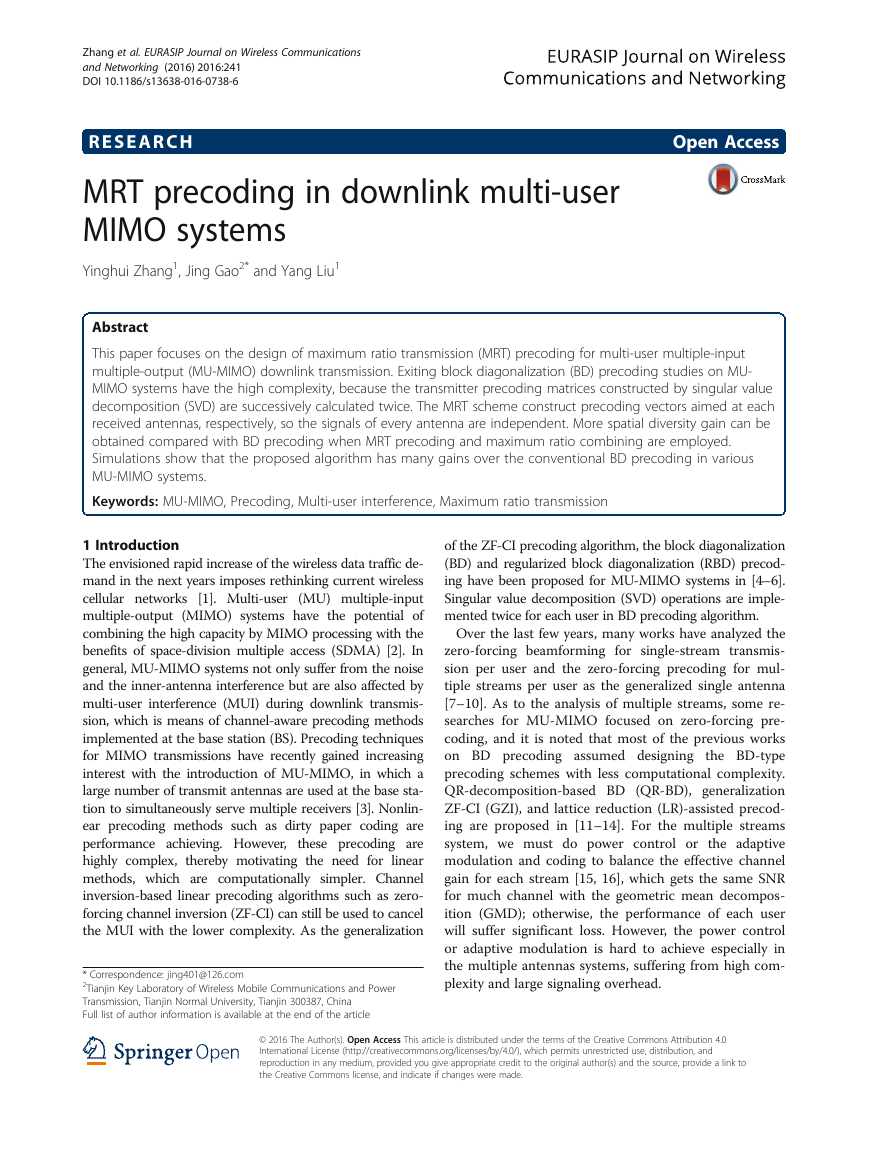
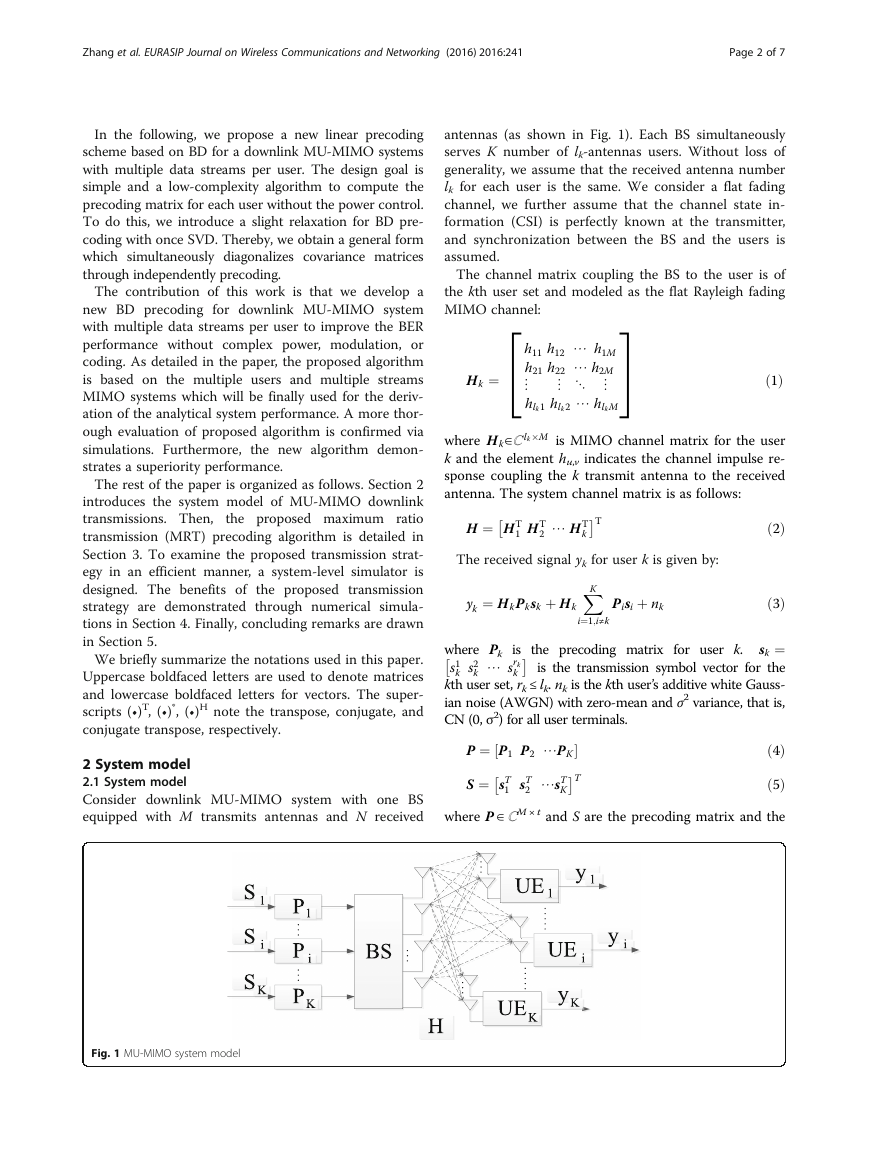
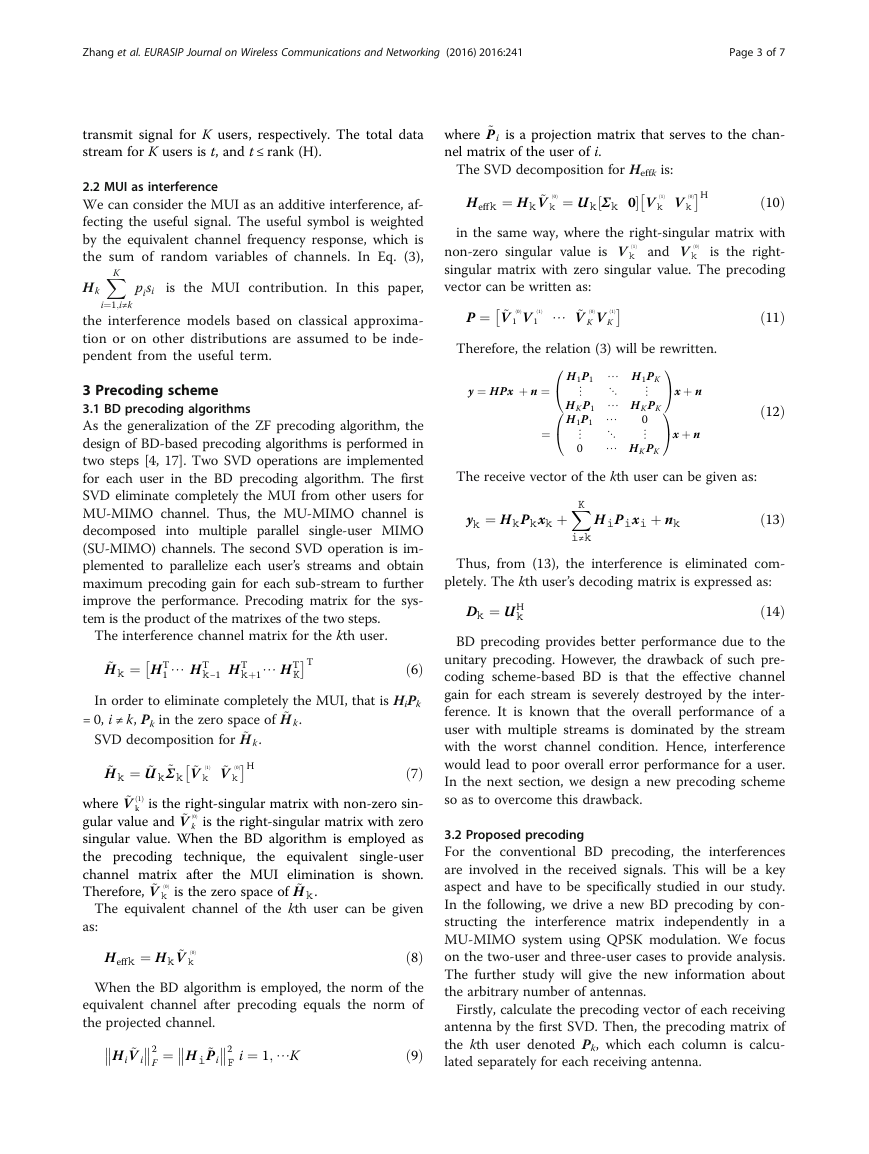

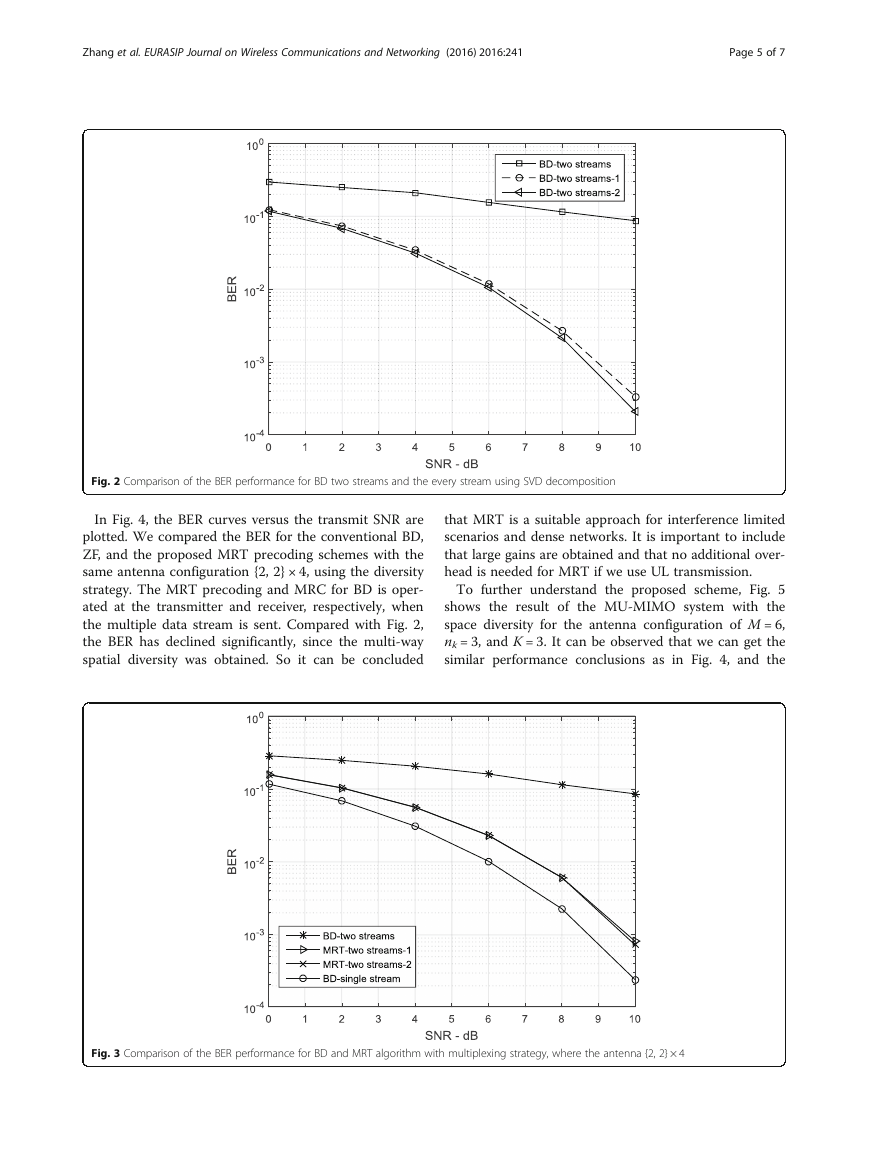
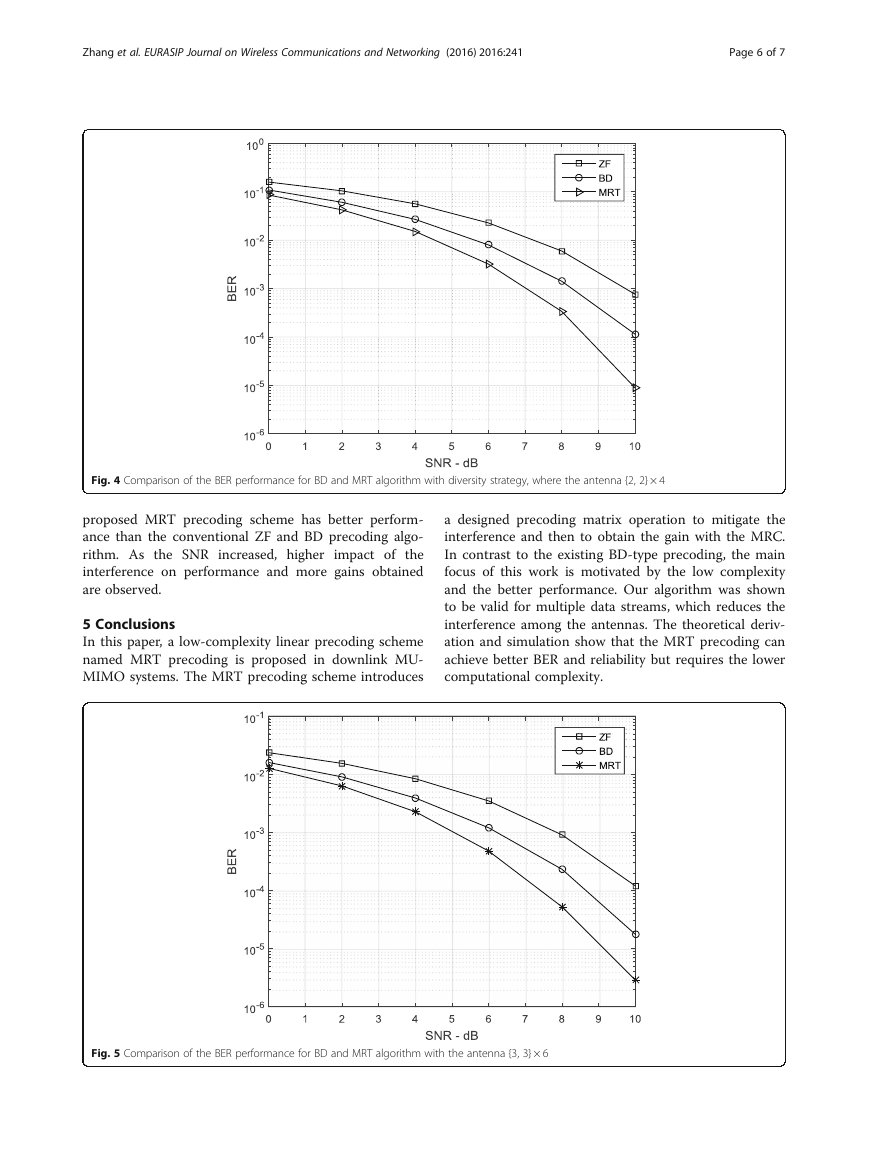
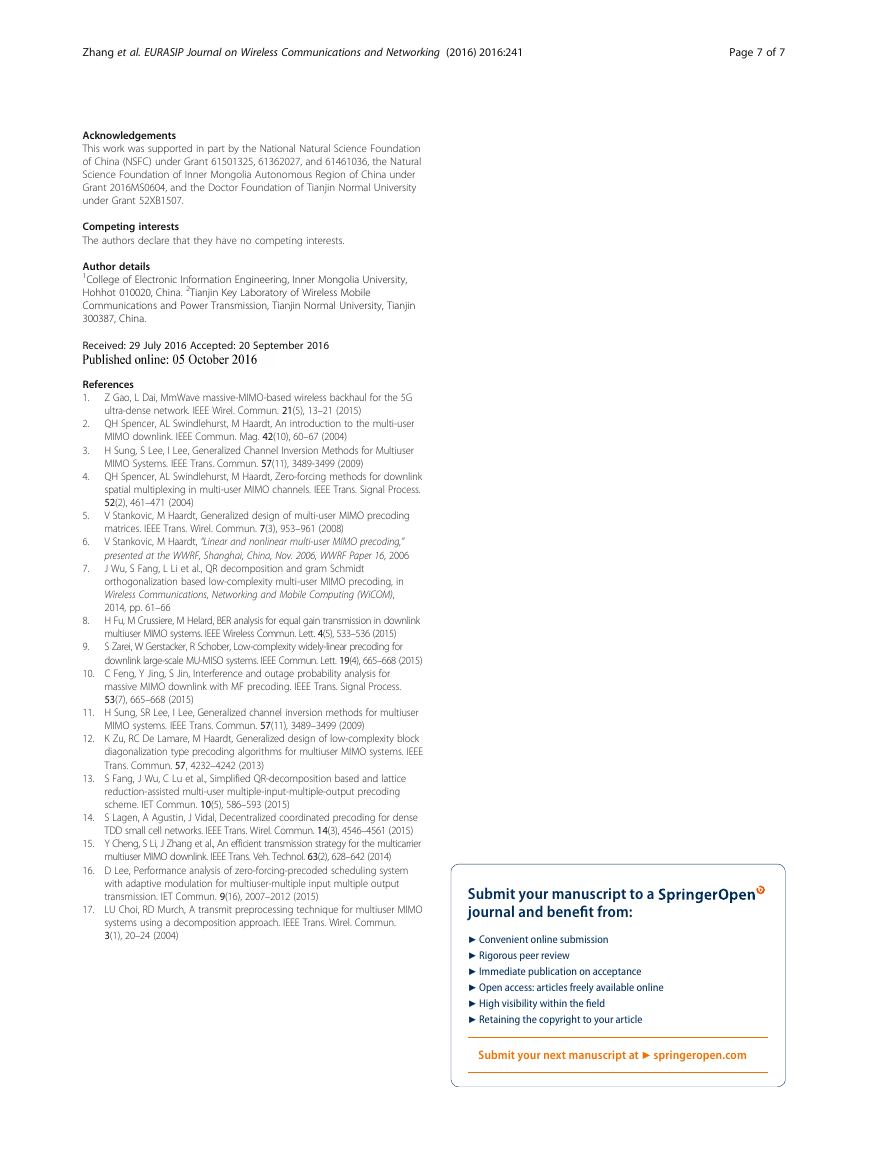







 2023年江西萍乡中考道德与法治真题及答案.doc
2023年江西萍乡中考道德与法治真题及答案.doc 2012年重庆南川中考生物真题及答案.doc
2012年重庆南川中考生物真题及答案.doc 2013年江西师范大学地理学综合及文艺理论基础考研真题.doc
2013年江西师范大学地理学综合及文艺理论基础考研真题.doc 2020年四川甘孜小升初语文真题及答案I卷.doc
2020年四川甘孜小升初语文真题及答案I卷.doc 2020年注册岩土工程师专业基础考试真题及答案.doc
2020年注册岩土工程师专业基础考试真题及答案.doc 2023-2024学年福建省厦门市九年级上学期数学月考试题及答案.doc
2023-2024学年福建省厦门市九年级上学期数学月考试题及答案.doc 2021-2022学年辽宁省沈阳市大东区九年级上学期语文期末试题及答案.doc
2021-2022学年辽宁省沈阳市大东区九年级上学期语文期末试题及答案.doc 2022-2023学年北京东城区初三第一学期物理期末试卷及答案.doc
2022-2023学年北京东城区初三第一学期物理期末试卷及答案.doc 2018上半年江西教师资格初中地理学科知识与教学能力真题及答案.doc
2018上半年江西教师资格初中地理学科知识与教学能力真题及答案.doc 2012年河北国家公务员申论考试真题及答案-省级.doc
2012年河北国家公务员申论考试真题及答案-省级.doc 2020-2021学年江苏省扬州市江都区邵樊片九年级上学期数学第一次质量检测试题及答案.doc
2020-2021学年江苏省扬州市江都区邵樊片九年级上学期数学第一次质量检测试题及答案.doc 2022下半年黑龙江教师资格证中学综合素质真题及答案.doc
2022下半年黑龙江教师资格证中学综合素质真题及答案.doc